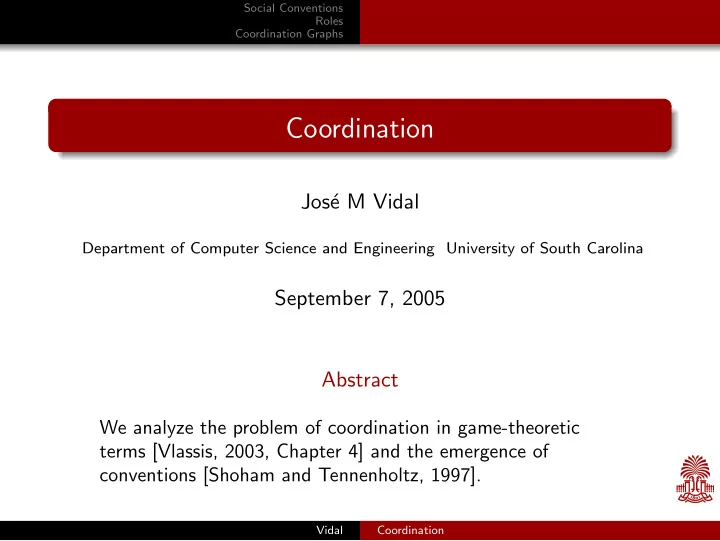

Social Conventions Roles Coordination Graphs Coordination Jos´ e M Vidal Department of Computer Science and Engineering University of South Carolina September 7, 2005 Abstract We analyze the problem of coordination in game-theoretic terms [Vlassis, 2003, Chapter 4] and the emergence of conventions [Shoham and Tennenholtz, 1997]. Vidal Coordination
Social Conventions Roles Coordination Graphs Coordination Game Alice Continue Swerve Continue -1,-1 5,1 Bob Swerve 1,5 1,1 Perhaps Alice and Bob should coordinate. In general, a game might have many Nash and Pareto equilibriums. We can say that coordination is the process via which agents agree on an equilibrium. A simple algorithm is for all agents to Determine all the equilibria. 1 Order them. 2 Pick the first. 3 Vidal Coordination
Social Conventions Roles Emergence of Social Conventions Coordination Graphs Social Conventions A social convention constraints the agents to only take certain joint actions. That is, it eliminates boxes in the payoff matrix. An equilibrium can be found faster. But, it might eliminate good equilibria. Vidal Coordination
Social Conventions Roles Emergence of Social Conventions Coordination Graphs Learning Social Conventions IDEA: Let agents learn social conventions (like the pigs). Highest Cumulative Reward (HCR) rule An agent switches to a new action iff the total payoff obtained from that action in the latest m iterations is greater than the payoff obtained from the currently-chosen action in the same time period. Vidal Coordination
Social Conventions Roles Emergence of Social Conventions Coordination Graphs Settings Prisoner’s Dilemma Coordination Game c d a b c 3,3 0,5 a 1,1 -1,-1 d 5,0 1,1 b -1,-1 1,1 Vidal Coordination
Social Conventions Roles Emergence of Social Conventions Coordination Graphs Guaranteed Convergence Theorem The HCR update rule guarantees eventual emergence of coordination and of cooperation, that is, rational conventions in the respective games. Vidal Coordination
Social Conventions Roles Emergence of Social Conventions Coordination Graphs Experimental Results Convergence is reduced as the update frequency is reduced. Erasing their memory too often prevents convergence, but system is resilient to occasional memory loss. Shorter memory windows m are better. Try out in my NetLogo implementation. Vidal Coordination
Social Conventions Roles Coordination Graphs Roles A role limits the actions an agent can take. By assigning roles we effectively reduce the size of the payoff matrix. Equilibria calculations are easier. Each role assignment represents a (possibly) different matrix, with new equilibria. Role assignment can be very hard to do optimally. Vidal Coordination
Social Conventions Roles Coordination Graphs Coordination Graphs Assume that the global payoff is the sum local payoff functions as in u ( s ) = f 1 ( s 1 , s 2 ) + f 2 ( s 2 , s 3 ) + f 3 ( s 3 , s 4 ) f 3 f 2 f 1 s 4 s 3 s 2 s 1 This can be drawn as We can now find the best strategy via iterative maximization. Vidal Coordination
Social Conventions Roles Coordination Graphs Iterative Maximization What is the best strategy? Eliminate agent 1: max u ( s ) = max s 2 , s 3 , s 4 { f 3 ( s 3 , s 4 ) + max s 1 ( f 1 ( s 1 , s 2 ) + f 2 ( s 1 , s 3 )) } s Vidal Coordination
Social Conventions Roles Coordination Graphs Iterative Maximization Resolve the inner max and let that value be f 4 ( s 2 , s 3 ), we then have max u ( s ) = max s 2 , s 3 , s 4 { f 3 ( s 3 , s 4 ) + f 4 ( s 2 , s 3 ) } s so agent 1 has been eliminated. Vidal Coordination
Social Conventions Roles Coordination Graphs Iterative Maximization We can eliminate agent 2 by defining f 5 ( s 3 ) to replace the old f 4 , we then have max u ( s ) = max s 3 , s 4 { f 3 ( s 3 , s 4 ) + f 5 ( s 3 ) } s and have thus eliminated agent 2. Vidal Coordination
Social Conventions Roles Coordination Graphs Iterative Maximization We eliminate agent 3 with the function f 6 ( s 4 ) so we are left with max u ( s ) = max s 4 f 6 ( s 4 ) s which agent 4 can solve by itself, choosing a ∗ 4 . This strategy can then be plugged into 3’s formula so it can calculate its strategy, and so on, until 1. This is faster than computing all equilibria in the full game. Vidal Coordination
Social Conventions Roles Coordination Graphs Conclusion Social conventions and roles are easy to implement and minimize communication and computations. A more sophisticated technique is negotiation, which requires communication and reasoning. Vidal Coordination
Social Conventions Roles Coordination Graphs Shoham, Y. and Tennenholtz, M. (1997). On the emergence of social conventions: modeling, analysis, and simulations. Artificial Intelligence , 94:139–166. Vlassis, N. (2003). A concise introduction to multiagent systems and distributed AI. Informatics Institute, University of Amsterdam. http://www.science.uva.nl/ ∼ vlassis/cimasdai . Vidal Coordination
Recommend
More recommend